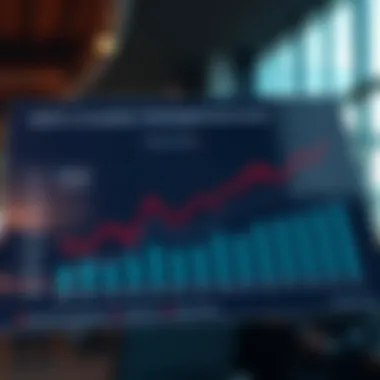Analyzing the Subprime Mortgage Crisis: Key Insights


Intro
The subprime mortgage crisis serves as a cautionary tale steeped in the rapid ascent and subsequent collapse of an overly ambitious financial market. Its echoes resonate through time, influencing not just the housing sector but also the wider economy. As we peel back the layers surrounding this crisis, it is essential to grasp the concepts and terminology underpinning the financial landscape of the early 2000s, as well as the ripple effects that still reverberate today.
In this exploration, we will dissect the core elements that contributed to the crisis, delve into the investment strategies that both failed and succeeded during this tumultuous period, and provide insights that aspiring investors can leverage moving forward. The subprime mortgage crisis isn’t merely a historical footnote; it’s a terrain littered with opportunities for learning, understanding, and refining investment tactics.
This guide sets the stage by illuminating critical terms often thrown around in financial discourse. By clarifying these concepts, we aim to empower readers to navigate similar issues with greater awareness. Let’s dive into our first section, shedding light on the investment terminology crucial to understanding the events surrounding the subprime mortgage crisis.
Investment Terminology
When grappling with the subprime mortgage crisis, it’s paramount to start with the foundational vocabulary that shaped conversations about risk, investment, and lending policies.
Key Definitions
Understanding fundamental terms is the first step towards grasping the complexities of the mortgage crisis. Some key definitions include:
- Subprime Mortgages: These are loans offered to borrowers with poor credit histories, typically characterized by higher interest rates due to the elevated risk of default.
- Mortgage-Backed Securities (MBS): These investment products are created by grouping together various mortgages and selling the resulting cash flows to investors, spreading both risk and reward throughout the financial system.
- Foreclosure: This is the legal process through which a lender can reclaim the property if the borrower fails to make mortgage payments.
Commonly Used Terms
In addition to basic definitions, several phrases emerged during this crisis that are critical for comprehending its broader implications:
- Collateralized Debt Obligations (CDOs): Financial instruments that pool various debt obligations, including mortgages, for resale to investors. They played a significant role in amplifying the risk exposure during the crisis.
- Default Rate: This term refers to the percentage of loans that borrowers fail to repay, a critical indicator of economic health within the mortgage sector.
- Liquidity Crunch: A situation where financial institutions face difficulties in obtaining enough cash to manage their obligations, often leading to drastic market adjustments and concessions.
Understanding these terms lays the groundwork for a deeper discussion about the strategies that investors employed during the crisis and the insight they provide for future markets.
“Recognizing the terminology is key to unlocking the narrative behind the numbers.”
With these definitions in mind, we will next explore the expert advice filtered through the lens of the crisis, uncovering strategies that not only highlight failures but also illuminate successful investment practices.
Preamble to the Subprime Mortgage Crisis
Understanding the subprime mortgage crisis requires delving into a topic that fundamentally altered the landscape of both finance and home ownership in the early 21st century. This crisis isn't just a historical blip; it serves as a crucial case for investors and financial enthusiasts alike. At its core, the analysis of the subprime mortgage crisis underscores the intertwining of economic policy, consumer behavior, and the overarching financial systems that govern home lending. Thus, grasping its significance is essential for those who wish to navigate or comprehend the intricate dynamics of today's mortgage market.
The subprime mortgage crisis brought to light a multitude of factors that contributed to its escalation—from aggressive lending practices to the sparse due diligence performed by financial institutions. For anyone involved in finance or investment, recognizing these pieces is not merely academic but practical. Learning from this disaster helps inform safer investment strategies and more prudent lending practices in the future.
Definition of Subprime Mortgages
Subprime mortgages refer to home loans that are provided to borrowers with poor credit histories, who are considered higher-risk compared to prime borrowers. These loans typically come with higher interest rates to compensate lenders for the increased risk associated with potential defaults.
To put this succinctly, a subprime mortgage can be viewed as a financial lifeline for some, yet it is also a double-edged sword. The promise of home ownership for individuals previously sidelined by traditional lending standards is enticing. However, it often leads borrowers into situations where they are unable to manage their repayments effectively, especially as interest rates rise or financial circumstances shift.
Historical Context and Preceding Events
A thorough understanding of the subprime mortgage crisis necessitates a look back at the events that preceded it. In the years leading up to the crisis, multiple interlinked factors converged to form a perfect storm. The United States saw a significant increase in home ownership, driven partially by government policies that encouraged lending to make buying homes more accessible.
During this period, the housing market was perceived as a gold mine—property values soared while lenders capitalized on this momentum to issue more subprime loans, often neglecting standard verification processes. At the same time, many financial innovations came into play, including various mortgage derivatives which obscured the risk involved. The combination of optimistic market psychology, lax credit standards, and the promise of ever-increasing property values laid the groundwork for a crisis that many now recognize as one of the biggest financial collapses in American history.
"The collapse was not just about mortgages, but a complex interplay of risk-taking behavior and systemic oversight failures that would ultimately reshape the future of financial regulation."
Thus, the subprime mortgage crisis showcases not only the vulnerabilities in lending practices but also serves as a cautionary tale for investors and policymakers. Understanding its definition and the historical context is pivotal for grasping the dynamics that led to the eventual fallout.
The Rise of Subprime Lending
The subprime lending phenomenon marked a seismic shift in the mortgage landscape, particularly in the arenas of accessibility and risk appetite. As lenders opened the floodgates to a broader spectrum of borrowers, including those typically excluded from conventional financing, several facets came into play, shaping the narrative leading to the subprime mortgage crisis.
Market Demand for Home Ownership
The insatiable desire for home ownership fueled the growth of subprime lending. In the early 2000s, a combination of low interest rates and rising housing prices created a perfect storm; individuals who previously thought homeownership was but a distant dream found themselves at the doorstep of possibility. People yearned for the American dream, and home ownership was seen as a crucial pillar. It was not just about having a roof over one's head; it symbolized stability, legacy, and even status. However, this demand came with an undercurrent of urgency, leading frenzied buyers to opt for loans that would, under different circumstances, not have been on the table for them.
- Affordability Issue: Many turned to subprime loans as traditional borrowing avenues were out of reach.
- Psychological Factors: The belief that property prices would always rise contributed to reckless borrowing.


Ultimately, homeownership became a ticket to perceived financial security, encouraging many to stretch their limits — often resulting in chronic debt.
Innovations in Mortgage Products
Innovations in mortgage products played a pivotal role in the rise of subprime lending. Lenders, eager to capitalize on the burgeoning market, developed a slew of intricate mortgage options tailor-made for high-risk borrowers. These mortgages often included features such as adjustable rates that started low before skyrocketing, balloon payments, and interest-only loans.
This wave of innovative but risky products offered something for everyone – or so it seemed. Some notable examples include:
- Adjustable Rate Mortgages (ARMs): These products typically offer lower initial interest rates, luring borrowers who might otherwise have stayed on the sidelines.
- No-Doc Loans: Designed for quicker processing, these loans required little documentation, significantly increasing the number of applicants but also the risk of default.
While these mortgage innovations expanded market participation, they also spread misaligned risk among lenders, borrowers, and investors. The complexity of these products made it hard for borrowers to understand the long-term costs.
The Role of Financial Institutions
Financial institutions have always played a critical role in shaping the lending landscape, but during the subprime lending boom, their involvement reached new heights. Motivated by the potential for profits, banks and mortgage companies began to aggressively market subprime loans, often prioritizing volume over prudent underwriting guidelines.
- Focus on Short-Term Gains: Many institutions were more concerned with the immediate profits generated from higher interest rates associated with subprime loans.
- Securitization: The bundling of these risky loans into mortgage-backed securities allowed institutions to offload default risk, further incentivizing them to continue issuing subprime mortgages with reckless abandon.
In this environment, the lines between risk management and profit motives blurred, contributing to a housing market bubble that was as unsustainable as it was enticing. As financial institutions facilitated the explosion of subprime lending, the stage was set for future calamity.
"The rise of subprime lending was driven by a potent mix of aspiration, innovation, and institutional recklessness, laying the groundwork for one of the most significant financial crises in history."
The rise of subprime lending was underpinned by a thirst for homeownership, the allure of innovative mortgage products, and a financial system eager to capitalize on the high-risk environment. It’s a classic tale of ambition and avarice, where risks were either inadequately assessed or blatantly ignored. Understanding these factors is crucial for grasping the profound implications that followed.
Mechanics of the Crisis
Understanding the mechanics of the subprime mortgage crisis is crucial for grasping how a seemingly stable financial system unravelled so spectacularly. This section lays bare the intricate web of factors and agents that contributed to the crisis, highlighting the significant roles played by mortgage securitization, credit rating agencies, and investor behavior. Delving into these components reveals not just what went wrong, but how various stakeholders, from lenders to borrowers, miscalculated risks and redefined norms in the mortgage market.
Securitization of Mortgages
Securitization refers to the process of transforming illiquid assets, like mortgages, into tradable securities. During the boom years preceding the crisis, financial institutions began repackaging home loans into mortgage-backed securities (MBS), enticing investors with promises of high returns and steady income streams. As these securities gained popularity, they were marketed to a broad array of investors, including pension funds and hedge funds.
However, here’s the kicker: the very mechanism that increased liquidity also masked the underlying risks associated with subprime loans. When lenders would offload these mortgages onto the open market, they often didn’t have much incentive to scrutinize borrowers’ creditworthiness. This lack of accountability led to a significant rise in subprime lending, with loans given to individuals with shaky financial backgrounds who often couldn’t keep up with their payments.
"Securitization created a false sense of security in the investment community, shielding the actual risk of default from the eyes of investors."
When the housing bubble burst, and defaults surged, these securities became liabilities instead of assets, triggering investments in these products to deteriorate. The domino effect was devastating, leading to financial institution failures and exposing the fragility of the entire financial system.
Credit Rating Agencies and Their Influence
Credit rating agencies play a pivotal role in the financial landscape by assessing the creditworthiness of different financial products. However, during the subprime crisis, agencies like Moody's and S&P are critiqued for their failure to accurately rate the mortgage-backed securities tied to high-risk loans. Often, these securities were given high ratings, which were misleading, presenting a façade of safety to investors.
This misjudgment stemmed from a combination of factors, including conflicts of interest; many rating agencies were compensated by the institutions whose products they assessed. Consequently, high-risk securities were cloaked in the same favorable ratings as safer investments. Investors, seeing these ratings as endorsements, often failed to conduct their due diligence.
The entire fiasco showed the grave consequences of relying on these agencies. When the truth surfaced, it was like letting the cat out of the bag: investors faced catastrophic losses, and the credibility of these agencies took a massive hit, prompting calls for more stringent regulations moving forward.
Investor Behavior and Risk Assessment
In the run-up to the crisis, the investor behavior was highly affected by a mix of greed and misplaced confidence. Many investors grossly underestimated the risk associated with subprime MBS, enticed by the allure of potential high yields. When house prices continued to rise, optimism ran rampant. Investors believed that the housing market could do no wrong, leading to a widespread failure in sound risk assessment. Decisions were made based not on comprehensive financial analysis, but rather, on a frothy market sentiment.
The eventual downturn in the housing market quickly became a wake-up call for investors who had pinned their hopes on unrealistic growth projections. As defaults flooded in, many investors found themselves caught in a vicious cycle, unable to recover their investments. This shift in perception profoundly altered how investors approach risk and prompted a reconsideration of investment philosophies that continue to resonate today.
By analyzing these mechanics, we uncover how the intersection of financial innovation, inadequate oversight, and collective behavior culminated in a crisis that reshaped the global economic landscape.
Triggers of the Collapse
Understanding the triggers of the subprime mortgage crisis is crucial for grasping how the financial market fell into disarray. Just as a house of cards can tumble with the flick of a finger, these triggers set off a chain reaction that led to widespread economic turmoil. Each of these factors played a role not only in igniting the crisis but also in demonstrating inherent flaws within the financial system, leading to catastrophic consequences. In this section, we will dive deeper into three primary triggers: rising interest rates, declining housing prices, and increasing loan defaults.
Rising Interest Rates
When central banks decide to raise interest rates, the impact is felt across the entire financial landscape. In the years leading up to the crisis, rates had been low, encouraging homebuyers to take out adjustable-rate mortgages that offered lower initial payments. As the Federal Reserve began to increase rates, many of these loans adjusted upward, leaving borrowers with monthly payments they could no longer afford. This sudden financial pressure can be likened to a balloon being slowly deflated until it bursts; eventually, the burden becomes too great.
Many homeowners found themselves stuck in a vicious cycle, unable to refinance due to declining home values or being trapped in unfavorable lending terms. The data paints a stark picture:


- In 2004, the Federal Reserve started raising rates from 1% to over 5% by mid-2006.
- This shift resulted in mortgage payments rising, often substantially.
Such increases were a tipping point for countless families who had over-leveraged themselves in an unforgiving market, leading many to default on their loans.
Decline in Housing Prices
The real estate market operates on a simple supply-and-demand principle, yet it can sometimes behave erratically. By 2006, a glut of housing stock, paired with rising interest rates and fading buyer confidence, began to tip the balance. Home prices that had been skyrocketing for years suddenly faced a reversal, resembling a rubber band stretched too far, snapping back into a tight constraint.
Some key indicators include:
- By 2007, home prices had dropped more than 10% from their peak.
- The once-volatile market was suddenly stagnant, exacerbating fears of a housing bubble.
The value of homes declined sharply, leaving many homeowners upside down on their mortgages (owing more than their properties were worth). This situation ignited fears among both consumers and lenders, creating a cascading effect that further clamped down on lending practices and investor confidence.
Increase in Loan Defaults
As interest rates rose and housing prices plummeted, the inevitable result was a spike in loan defaults. It became a classic case of being caught between a rock and a hard place for many homeowners. The easy credit that had initially allowed them access to homeownership became a double-edged sword, cutting deep as defaults rose.
Defaults surged, resulting in foreclosures that flooded the market with distressed properties. The numbers are daunting:
- Foreclosure rates reached over 4% by 2008, a drastic increase from just 1% in previous years.
- Major lenders found themselves facing billions in losses, contributing to a loss of consumer trust.
These defaults weakened financial institutions, exposing them to substantial risks associated with the securitized mortgage investments they had made during the preceding lending boom. Without adequate risk management and regulation, the financial system was placed on shaky ground, eagerly awaiting the next shock to its foundation.
“The rising interest rates, declining housing prices, and increasing loan defaults formed a toxic cocktail that spiraled out of control, leading to the collapse.”
Impact on the Financial System
The financial system is the backbone of economic stability and growth. The subprime mortgage crisis, however, revealed vulnerabilities that had been lurking beneath the surface for years. The importance of understanding the implications of this crisis cannot be overstated. Financial institutions, regulatory bodies, and investors alike learned hard lessons that still resonate today. By dissecting the impact on the financial system, we can both appreciate its intricacies and understand the changes that followed.
Financial Institution Failures
The failures of major financial institutions during the subprime mortgage crisis were not just moments of corporate distress; they marked a seismic shift in the landscape of finance. Institutions like Lehman Brothers collapsed, sending shockwaves throughout the markets. This collapse wasn't an isolated incident; it was a culmination of risky lending practices, inflated asset valuations, and complex financial instruments that no one fully understood.
- Interconnectedness of Banks: The failure of one institution led to a cascading effect. Investors lost trust, and liquidity evaporated. Banks were interlinked through derivatives and mortgage-backed securities, meaning that when one bank fell, others were dragged down with it.
- Loss of Investor Confidence: With these failures, investors began to panic. The uncertainty triggered a sell-off, creating a liquidity crisis that crippled banks, leading them to hoard cash instead of lending it out. This contraction had a ripple effect on the broader economy, stalling growth.
Global Economic Repercussions
The repercussions of the subprime mortgage crisis traveled far beyond U.S. borders. Countries that were thought to be insulated from the American financial system quickly felt the heat. This global interconnectivity was not just a result of direct financial ties but also of shared economic dependencies. Some critical points include:
- Foreign Banks in Trouble: European banks exposed to U.S. subprime loans faced significant losses, leading to a credit crunch in several markets. Losing faith in the stability of these institutions created challenges for entire economies, slowing down growth across various regions.
- Rising Unemployment: With the economic downturn, industries that relied heavily on consumer spending suffered. Job losses and reduced disposable income only exacerbated the situation. Households that had benefited from easy lending found themselves unable to pay mortgages, which in turn deepened the crisis.
The intertwined nature of today's financial landscapes means that events in one part of the world can echo across the globe, often with devastating effects.
Policy Responses and Bailouts
As the fallout from the crisis unfolded, governments around the world took measures that reshaped policy in both the short and long term. The responses varied but generally reflected a desire to restore stability and confidence in the financial system:
- Bailouts: Governments, particularly in the U.S., stepped in to prevent further collapses. Institutions such as Fannie Mae and Freddie Mac were placed under government conservatorship to support the housing market and maintain stability. The auto industry also received assistance to prevent job losses and economic collapse.
- Regulatory Reforms: New regulations, like the Dodd-Frank Wall Street Reform and Consumer Protection Act, were enacted. These aimed to increase oversight of financial institutions and mitigate risks that could lead to another crisis. The creation of the Consumer Financial Protection Bureau (CFPB) had a significant impact on lending practices, pushing for greater transparency and consumer protection.
- Monetary Policy Adjustments: The Federal Reserve slashed interest rates to near-zero levels to stimulate growth and encourage lending. These changes fundamentally altered monetary policy and created new challenges regarding inflation and asset bubbles in the years to come.
For further insights, see Britannica on Financial Crises and Wikipedia's Overview of the 2007-2008 Financial Crisis.
Lessons Learned from the Crisis
The subprime mortgage crisis doesn’t just reside in the rearview mirror of financial history; it serves as a profound teacher, laying bare critical lessons for all stakeholders involved in financing and investment. Understanding these lessons is paramount, not only for preventing similar occurrences in the future but also for nurturing a more resilient economic landscape. Breaking this down seems essential as we navigate the complexities of mortgage lending and investment behaviors today.
Regulatory Changes Post-Crisis
In the aftermath of the subprime mortgage crisis, it became glaringly obvious that the existing regulatory framework was ill-equipped to handle the nuances of modern financial markets. Legislators, propelled by public outcry and economic turmoil, initiated sweeping reforms aimed at bolstering consumer protections and stabilizing the lending environment. The Dodd-Frank Wall Street Reform and Consumer Protection Act, for instance, emerged as a landmark piece of legislation, ushering in rules that mandated greater transparency in mortgage lending practices.
These reforms emphasized the necessity for lenders to ensure borrowers possessed the ability to repay loans. This shift not only protects consumers but also builds a sturdier financial system that could prevent reckless lending we observed prior to the crisis. Moreover, the establishment of the Consumer Financial Protection Bureau (CFPB) stood out as a significant move to oversee and regulate mortgage lending, bringing more accountability to the marketplace. Not only do these changes serve to safeguard consumers, but they also cultivate greater trust within the financial system, vital for economic recovery.


Importance of Risk Management
Risk management isn't an optional extra; it’s the cornerstone of sustainable financial practices. The crisis taught harsh truths about the consequences of neglecting thorough risk assessment. Financial institutions found themselves entrenched in a web of dubious assets, often overlooking or miscalculating the risks associated with mortgage-backed securities. As a result, the catastrophic failure of major banks showed that a sound risk management strategy could have alleviated some of the chaos.
In today’s world, rigorous risk assessment extends far beyond conventional models. Financial entities are now adopting more sophisticated methodologies, such as stress testing and scenario analysis to understand potential vulnerabilities. The goal is clear: by ensuring every possible scenario is considered, organizations can better prepare for future upheavals. A well-executed risk management strategy not only protects firms from unforeseen losses but also builds resilience against systemic shocks, fostering a more stable economy overall.
Evolving Investor Perspectives
The subprime mortgage crisis acted like a wakeup call for investors, reshaping their perspectives and altering their strategies significantly. Before the crisis, many investors were lured by the promises of quick profits from mortgage-backed securities. Today, there is a marked shift toward scrutinizing the underlying fundamentals of investments. Many now understand the importance of evaluating not just the potential returns but also the risk associated, creating a more balanced approach to investing.
Investors have since become more data-driven in their assessments. They rely on a combination of quantitative analysis, credit ratings, and even qualitative metrics, such as the borrower’s financial stability, to gauge investment soundness. This evolution reflects a broader recognition that due diligence is not just good practice; it’s essential for safeguarding against potential pitfalls. As the landscape continues to evolve, investors are more focused on long-term performance rather than quick gains, thereby reinforcing a more robust investment ecosystem.
In essence, the lessons learned from the subprime mortgage crisis are indispensable. They not only shape current practices but also guide future actions and policies within the financial sector. Having a keen awareness of these lessons can empower individuals and institutions alike to navigate the ever-changing waters of mortgage lending and investment with confidence.
Current Landscape of Mortgage Lending
The landscape of mortgage lending today finds itself vastly altered as compared to the days preceding the subprime mortgage crisis. A variety of factors have shaped this environment, from regulatory changes moving the goalposts for lenders, to evolving consumer preferences calling for a more transparent and responsible lending process. This section outlines the critical characteristics that define current mortgage lending practices, addressing how these dynamics not only reflect lessons learned from the past but also cater to the present-day market's realities.
Changes in Lending Standards
One of the most significant shifts in the mortgage lending landscape is the enhancement of lending standards. Post-crisis regulations such as the Dodd-Frank Act implemented a series of measures to tighten credit issuance.
- Stricter Requirements: Lenders now require thorough documentation of a borrower's income and credit history, reducing the occurrence of high-risk loans.
- Qualified Mortgages: The introduction of the Qualified Mortgage rule ensures that loans meet specific standards, providing a layer of protection for consumers.
- Limitations on Fees: There are now caps on the fees a lender can charge, aimed at preventing predatory lending practices.
All these changes make it harder for borrowers with lower credit scores to qualify, essentially steering clear of the reckless lending behavior seen before the crisis.
Emerging Trends in Financing
While the lending standards have tightened, some trends are worth noting in the current financing landscape. The rise of technology-driven finance has reshaped how mortgages are processed and delivered:
- Online Mortgage Services: Platforms like Rocket Mortgage and LoanDepot streamline the application process through digital means, allowing borrowers to get approved faster than in traditional settings.
- Alternative Data Use: To assess creditworthiness, lenders are increasingly using non-traditional data points such as utility payments or rent. This method opens up opportunities for potential buyers who might have been overlooked in earlier systems.
- Interest Rate Flexibility: Adjustable-rate mortgages are gaining some traction, as buyers look for lower initial rates in a fluctuating market, but with a clear understanding of the associated risks.
These trends indicate a pivot toward more efficient and inclusive practices.
Consumer Awareness and Education
Another vital component of the mortgage lending environment today is the focus on consumer awareness and education. The crisis revealed that many borrowers did not fully understand the terms of their loans, leading to disastrous outcomes. To combat this:
- Financial Literacy Programs: Many organizations and lenders have developed programs aimed at educating homebuyers about the mortgage process and their rights. This is crucial as informed buyers are less likely to fall prey to predatory lending.
- Resource Accessibility: The availability of online tools and calculators has empowered consumers to better understand their financial positions, making them more informed when entering the market.
- Regulatory Guidance: Agencies like the Consumer Financial Protection Bureau (CFPB) actively provide resources and guidance to help consumers navigate the complexities of mortgages.
This heightened sense of awareness contributes to a more robust borrower-lender relationship, ultimately fostering a healthier mortgage market.
As the mortgage lending landscape evolves, it is clear that the lessons learned from the subprime mortgage crisis have paved the way for a more sustainable and consumer-friendly approach.
In summary, the current landscape of mortgage lending is characterized by tighter standards, emerging technologies, and robust consumer education. Acknowledging these shifts not only helps to comprehend the present environment but also provides insights for moving forward in home ownership and investment.
Epilogue
The subprime mortgage crisis serves as a critical case study in financial history, shedding light on the intricate interplay between lending practices, regulatory oversight, and market behavior. In a time when home ownership was ramping up, the convergence of high-risk lending and poor economic foresight led to a series of unprecedented consequences. Examining these elements not only helps to understand past missteps but also illuminates the path forward for investors, policymakers, and consumers alike.
Reflections on the Subprime Mortgage Crisis
The aftermath of the subprime mortgage crisis left painful scars on the financial landscape. Many individuals lost their homes, while entire communities bore witness to economic stagnation. The ripple effect was widespread, with financial institutions collapsing under the weight of their own recklessness.
Reflecting on this crisis highlights several key insights:
- The Necessity of Due Diligence: Investors must now question the soundness of their investments—not just trust in ratings and reassurances.
- Consumer Empowerment: The crisis sparked an movement towards greater consumer education, encouraging individuals to truly understand the products they engage with.
- Regulatory Oversight: This crisis showcased the repercussions of inadequate regulatory frameworks. Policymakers now find it essential to enforce stringent controls to prevent similar systemic failures.
"Those who forget the past are doomed to repeat it." This adage rings true as it encourages reflection not just on the mistakes made but also the potential disasters avoided through vigilance and reform.
Future Considerations for Investors
The lessons from the subprime mortgage crisis underscore the importance of adaptability in financial strategies. Modern investors need to keep a close eye on market trends, regulatory measures, and macroeconomic indicators. A few key considerations include:
- Diversification: In an uncertain market, spreading investments across various asset classes can mitigate risk.
- Critical Analysis: Going beyond surface-level metrics to assess the intrinsic value of investments in mortgage-backed securities or real estate funds is crucial.
- Regulatory Awareness: Staying informed about regulatory changes can guide investment choices. New measures might affect market dynamics and potential returns.
While the world of investments is ever-evolving, the shadow of the subprime crisis serves as a reminder that the pursuit of profit must be matched with prudence and informed decision-making. As the landscape unfolds, those who equip themselves with knowledge will be better prepared to navigate the complexities ahead.
For further reading on financial standards and pertinent regulations, you can explore resources like SEC.gov, Consumer Financial Protection Bureau, or the Federal Reserve.















